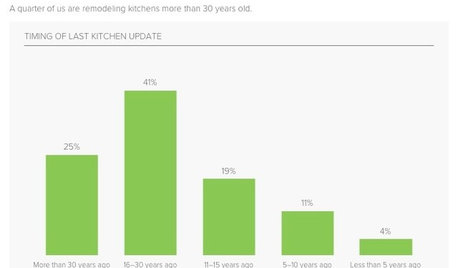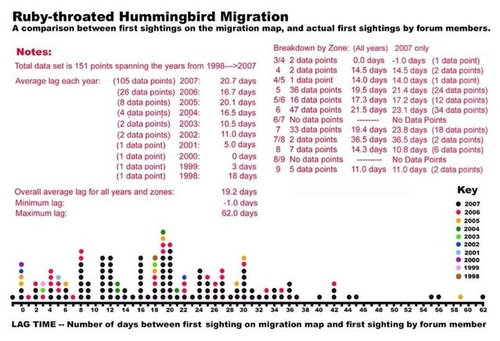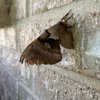Hello all. Earlier this spring, like many of us, I watched Lanny Chamber's Hummingbird Migration map. See the link at the very bottom, if you're not familiar with this site. As the Ruby-throated hummingbirds began to move northward, people from North America reported their first sightings, beginning in the gulf coast and moving northward. These earliest sightings in each area appeared as colored dots on Lanny's migration map with dates beside them.
This map is very useful because it gives people an idea of when the very first Ruby-throats are returning to various parts of the United States and Canada. When dots start to appear nearby us on the map, we know that the birds may soon be returning and we should put out flowers and feeders for them.
Trouble is, the migration of hummingbirds in any given area is drawn out over several weeks, and for that reason, looking at Lanny's map can get very frustrating. Dots appear all around you, but for many of us, our first hummingbird may not be seen for days or even weeks after those first dots appear. No matter how hard I tried to tell myself that these were FIRST sightings, I couldn't help but feel frustrated that "my" birds weren't returning. There were many first sightings far to the north of me before I saw my first. I know I wasn't alone in this feeling, and I think my impatient reaction was pretty typical.
So, with this in mind, I got the idea to do a survey of the members of this forum, and also from the Hummingbird Forum. Many people willingly contributed their first sightings, and I was delighted with the level of response. I also searched back over previous threads and included every first sighting that I could find in 2007 and in years past.
The whole point of collecting all this data was to compare the date of each of these sightings with the nearest dot(s) corresponding to first sightings on the migration map. What I found was no surprise. For most people, there was a significant lag between the first report on the migration map, and that particular person's first sighting in their own yard. The whole point of this survey was to figure out the average lag, and look for any other interesting correlations.
------------------------------------------------------------
Here are the results written out:
TOTAL NUMBER OF REPORTS FROM FORUM MEMBERS:
(Includes data from 1998 through 2007)
151
RANGE OF LAG TIMES:
One person actually saw their first hummingbird a day before their nearest first report on the map. I'm not sure if this person tried to report it on Lanny's map and was rejected, or whether there was no attempt to report it.
Only six people out of 151 actually saw their first on the same day as the first map report in their area. Some of these might have been the same people to submit their reports to the migration map.
The remaining 144 people had to wait anywhere from 1 to 62 days to see their first bird after the first in their area was recorded on the migration map.
THIS IS THE AVERAGE LAG BETWEEN FIRST MAP SIGHTING AND FIRST SIGHTING BY FORUM MEMBERS--151 DATA POINTS (ALL YEARS FROM 1998 TO 2007 INCLUSIVE):
19.2 days
AVERAGE LAG IN 2007--105 DATA POINTS:
20.7 DAYS
2007 was the longest lag of any of the years. I also had a disproportionate number of data points for the middle zones, and I suspect that the lag times were most strongly affected in these zones. When the cold snap hit in early April, most people had already seen their first hummingbirds in zone 9 and 8, so their lag times were probably not affected. However, when the cold snap hit in zones 7, 6, and 5, birds were just starting to appear on the map, and yet most people in these zones had not yet seen their firsts. The cold weather delayed everything and caused slightly longer lag times between map and member sightings. As for the more northerly zones of 4 and 3, I'm thinking that since there were no first map reports in these zones when the cold hit in early April, people in these zones may have been less affected by the lag. Although the dates of their first sightings may have been later than average, the first map reports were probably later as well. Unfortunately, this is all just speculation, because I don't have enough data points in the more southern and in the more northern zones.
--------------------------------------------------------------
Here is the graph:
I hope you were all able to make some sense of this. In case you missed it, and your eyes glazed over somewhere in the middle, the main point is this:
COMPARED WITH THE FIRST REPORTS ON THE MIGRATION MAP, THE AVERAGE FORUM MEMBER WILL WAIT 19.2 DAYS BEFORE SEEING THEIR FIRST HUMMINGBIRD.
Finally, I'd like to thank everyone who contributed their reports. I really appreciate it!
Here is a link that might be useful: Lanny Chamber's Migration Map


















yardenman
kristin_williamsOriginal Author
Related Professionals
Graham Landscape Architects & Landscape Designers · Simi Valley Landscape Architects & Landscape Designers · Peabody Landscape Contractors · Biloxi Landscape Contractors · Brandon Landscape Contractors · Mequon Landscape Contractors · Salem Landscape Contractors · Welby Landscape Contractors · Wickliffe Landscape Contractors · Woodland Landscape Contractors · Vadnais Heights Landscape Contractors · Midlothian Decks, Patios & Outdoor Enclosures · Pittsburgh Decks, Patios & Outdoor Enclosures · Rantoul Decks, Patios & Outdoor Enclosures · Rosemont Decks, Patios & Outdoor Enclosuresbospanky
lucygreenthumb